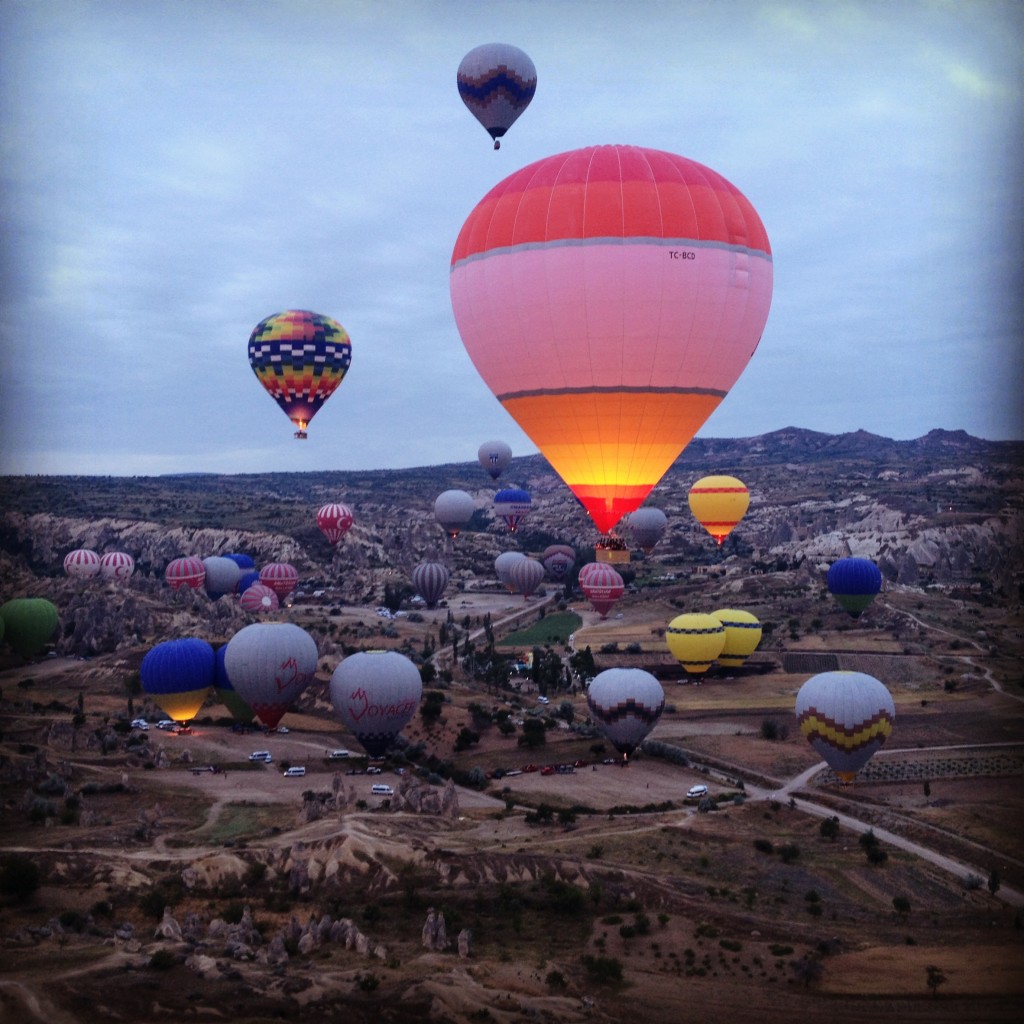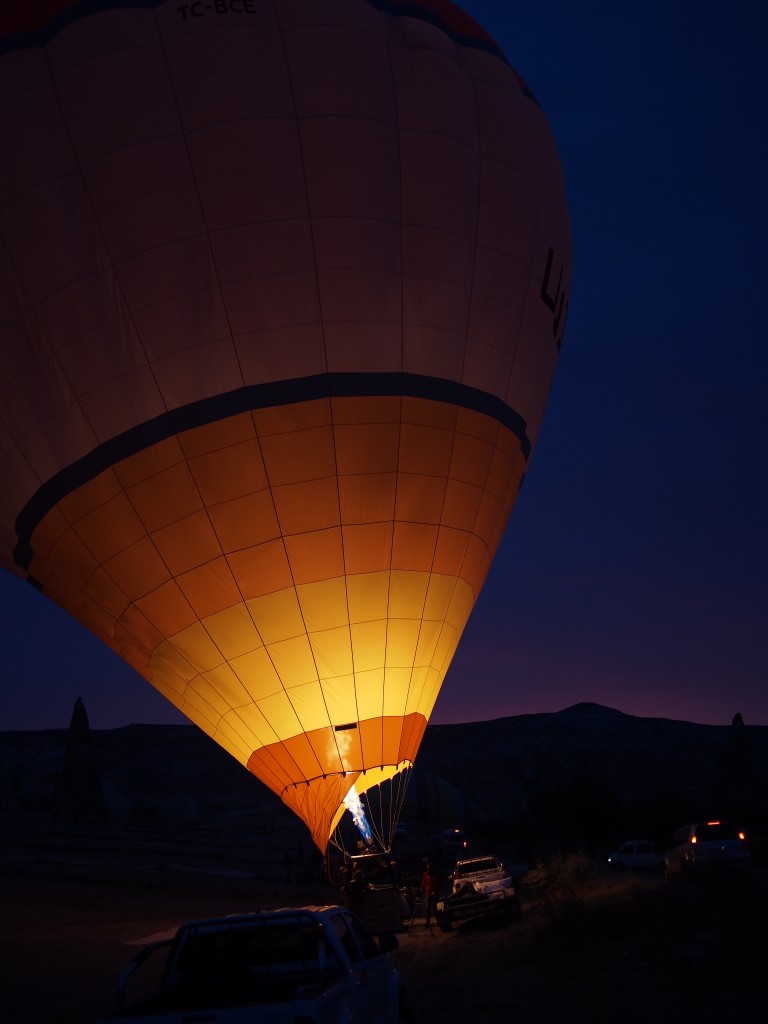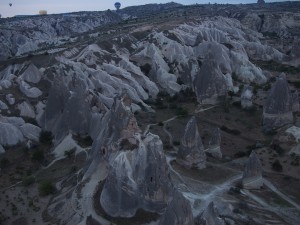On June 2nd we left Istanbul for Cappadocia, which is located roughly in central Turkey. The area is a must-see on the Turkey tourist circuit largely because of its landscape, particularly the “fairy chimneys,” so Rachel and I decided to check it out.
Fairy chimneys: The landscape in the Cappadocia region features large chimney-like structures shooting out of the ground all over the place. (If you’re one of the 10 people familiar with the landscape between Casper and Shoshoni, Wyoming, it looks similar but on a slightly larger scale.) Some of the chimneys are large enough that inhabitants of the region used them for housing, worshiping, gathering, etc. Along with some really interesting landscape the area is home to manmade caves, which, in some cases, continue to serveas homes to the local residents.
Just to get the record straight, when we first heard about fairy chimneys Rachel said, “I want to stay in a fairy chimney!” Acccordingly I did a little research– at the time neither of us knew what one was. It turns out that some hotels in the area take advantage of the local architectural eccentricities and have cave hotel rooms. Now, based on Rachel’s statement and my initial research I made the leap (a pretty small leap in my mind) that she wanted to stay in a cave. A nice cave but a cave nonetheless. When we arrived at our hotel and she finally saw our cave dwelling, she assumed it was through my curiosity/insanity that we’d chosen such a place. It didn’t take long for both of us to realize that neither really wanted to stay in a cave and, while sort of an interesting concept, staying in a cave isn’t actually that great. It smells, it’s dark and there aren’t really walls separating the rooms. She also pointed out that there’s a difference between a fairy chimney and a manmade cave. Oops.
Anyway, during our four day visit we split our time between touring local sights, going on hikes and visiting cafes and restaurants.
On our first day we went to what seems like the most visited spot in the area, the Goreme Open Air Museum. The museum is a collection of old cave monasteries and features a number of chapels with well preserved frescos on the ceilings and walls. While very nice, it was packed with tour groups causing large hordes to pile into small cave chapels and it was hot, so, as soon as we took in the major sights, we made our exit.
Our next stop was a hike in Pigeon Valley. The name comes from the pigeon houses cut into the cliff sides of the valley walls. Breeding and training pigeons for regional competitions is serious business in the area, so the pigeons are well taken care of. The hikes were my favorite part of Cappadocia. Every one was different, and the trails were largely ignored by the tour groups, so, along with beautiful scenery, they provided a nice escape from the crowds.
On our second day of exploring, we woke up at 4:30 AM to go hot air ballooning. If you’re like me, activities like hot air ballooning often sound suspicious– they’re inevitably expensive, short-lived and often not that great. However, hearing from different people that it was a must in Cappadocia, we decided to go for it. It turned out to be great. Viewing the valley from the air was interesting but predictably so-so–better when closer to the ground, which kind of defeats the purpose. The real fun was in the dozens of other hot air balloons taking off at roughly the same time as us. Our pilot called it the “ceremony of the skies” which captures the mood in a whimsical sort of way.
After ballooning we set out for more adventures. We drove south to a place called Keslik, home to a cave monastery. Keslik is far enough from the major attractions that we were nearly the only visitors, which allowed us to explore the many caves making up different rooms of the monastery such as the chapel, community eating area and wine cellar. (It turns out Byzantine monks were our kind of monks– always with a stocked wine cellar.) After Keslik we did a drive-by of Devrent Valley, a heavily visited attraction featuring rocks in the shape of camels, toads, etc.
Our next major stop of the day was a hike through Rose Valley. As with the day before, the hike was my favorite part of the day. The landscape is beautiful, the trails aren’t too long and there’s enough shade that the heat isn’t so oppressive.
After our hike (and a beer or two) we were hot and tired, and took the opportunity to check another Turkey must-do off of our list: We went to a hammam, or Turkish bath. Our tiny hammam was unisex, (somewhat rare in Turkey) so we could go together. (Other hammams are either for men or women, or, more commonly, have set days or areas for each sex.)
I was a little hesitant but feeling the spirit of adventure I went. I don’t like messages. Generally speaking I don’t like it when strangers touch me. Our hammam started with a 5-10 minute sauna, then it proceeded to a rest time of about 15 minutes when we lounged on a large and warm marble stone in the middle of a hot room. So far so good. Next, we were brought into a room and scrubbed with a rough wash cloth. The result is gnarly– all of the dirt, toxins and other nastiness that the sauna brought out were scrubbed off of us which the nice man showed to me many time to prove how much I needed the treatment. Then, we were washed and massaged. I have to admit, it was pretty enjoyable… I actually liked it.
On our last day in the area, we drove south to the underground city of Kaymakli. The several underground cities in Cappadocia are thought to date back to the Hittites– they were built to be used for short times when the population was under attack. The more recent occupants were Byzantine Christians in the 6th and 7th centuries who used and extended the cave cities for the same purpose.
Kaymakli is a city with nearly 100 tunnels connecting rooms over eight levels. Only four of the levels are open, but it’s enough to get a feel for the enormity and complexity of the place.
After the underground city, we went for a hike in Zemi Valley. The hike didn’t last long, because we heard thunder and looked around to realize we were hiking in a flash flood area. But during the short distance, it proved to be yet another beautiful and deserted trail.
















Did you conclude your sunrise balloon ride with champagne like we did in Siena?
Scenery really does look like Casper-Shoshoni, say I, one of the 10 people who have driven the route…oh, maybe 100+ times. Maybe more.
thanks for sharing